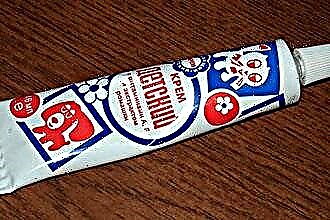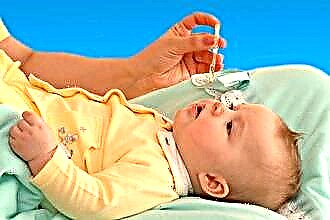Local treatment of infectious diseases with compresses is aimed at resolving infiltrates in the ENT organs and reducing the viscosity of sputum inside the bronchi. Physiotherapy procedures help to convert a dry cough into a productive form with the separation of viscous sputum. How to put a cough compress to a child?
 In pediatric therapy for the treatment of ENT pathologies, mainly wet applications based on drugs and warming agents are used. The effectiveness of physiotherapy is achieved due to the reflex expansion of blood vessels under the influence of heat. The activation of blood circulation stimulates the work of the glands of the ciliated epithelium, as a result of which the evacuation of mucus from the airways is accelerated. Cleansing the lungs from pathological secretions leads to the elimination of the main irritant that affects the cough receptors.
In pediatric therapy for the treatment of ENT pathologies, mainly wet applications based on drugs and warming agents are used. The effectiveness of physiotherapy is achieved due to the reflex expansion of blood vessels under the influence of heat. The activation of blood circulation stimulates the work of the glands of the ciliated epithelium, as a result of which the evacuation of mucus from the airways is accelerated. Cleansing the lungs from pathological secretions leads to the elimination of the main irritant that affects the cough receptors.
Types of compresses
What cough compresses for children can be used to treat colds? Conditionally medical cotton-gauze dressings are divided into two types: dry and wet. In turn, wet applications are divided into cold, hot and warming. In the treatment of ENT diseases, warming compresses are used, which have a broad spectrum of action:
- anti-inflammatory;
- wound healing;
- antimicrobial;
- immunostimulating;
- decongestant.
Important! Warming compresses should not be applied to children under the age of 1-1.5 years - this is due to the risk of burns on the skin.
To stop dry and unproductive coughs, it is more advisable to use oil and vodka medicinal dressings, the components of which quickly penetrate the tissues and eliminate inflammation in the mucous membranes of the throat and bronchi. In the treatment of wet cough, water and medicinal compresses are often used, which facilitate the expectoration of phlegm and restore the ventilation function of the lungs.
The principle of operation of compresses
 How do warming applications help to eliminate cough syndrome? It should be understood that cough is a protective and adaptive reaction that occurs as a result of irritation of cough receptors. Inflammatory processes in the ciliated epithelium stimulate the secretion of viscous mucus, which flows down the walls of the pharynx and irritates the cough receptors. It is possible to eliminate an unpleasant symptom only in the case of liquefaction and removal of pathological mucus from the airways.
How do warming applications help to eliminate cough syndrome? It should be understood that cough is a protective and adaptive reaction that occurs as a result of irritation of cough receptors. Inflammatory processes in the ciliated epithelium stimulate the secretion of viscous mucus, which flows down the walls of the pharynx and irritates the cough receptors. It is possible to eliminate an unpleasant symptom only in the case of liquefaction and removal of pathological mucus from the airways.
Warming compresses play the role of activators that accelerate blood microcirculation in the affected tissues. Intensive oxygen supply of epithelial cells stimulates metabolic and regenerative processes. In addition, warming up the ENT organs promotes the production of interferon in the body, which takes part in the destruction of pathogens.
Important! You can not put a compress when coughing a child with blood diseases, thrombophlebitis and a tendency to bleeding.
The use of warming medical dressings stimulates the increase of local immunity. Due to this, the regression of inflammation is accelerated, which leads to a decrease in the excess amount of mucus on the walls of the airways. The absence of an irritant helps to eliminate the cough syndrome and improve the child's well-being.
Compress rules
How to put a compress when a child coughs? The effectiveness of the procedure is determined by the correct application of a medical bandage. To achieve the desired results, it is necessary to achieve a minimum heat exchange with the outside of the heating compress. To do this, you must take into account several important rules:
 before applying a bandage, the skin should be lubricated with petroleum jelly, baby cream or vegetable oil;
before applying a bandage, the skin should be lubricated with petroleum jelly, baby cream or vegetable oil;- applications are placed exclusively on the back, chest (except for the heart area), lateral and back of the neck;
- a damp gauze or cotton cloth is covered with a waterproofing material - waxed paper or polyethylene;
- the bandage is insulated with a layer of cotton wool or flannel fabric, the width of which exceeds the width of the previous layers by 1.5-2 cm;
- after the procedure, the skin should be wiped dry and lubricated with cosmetic oil or baby cream.
Important! To prevent overheating of fabrics, it is better to use compressor paper as a heat insulator, rather than polymeric materials (cellophane, polyethylene).
Potato compress
Boiled potatoes keep warm for a long time, so they can be used as a warming agent during local therapy for ENT diseases. Intense warming of the chest stimulates reflex expansion of blood and lymphatic vessels, which prevents congestion in the lungs. Potato compresses accelerate the passage of mucus from the walls of the ENT organs, which accelerates the evacuation of pathological secretions from the airways.
During therapy, care must be taken that the potatoes are not too hot. Otherwise, the occurrence of a burn on the skin is not excluded. How to make a compress for a child?
- boil 3 peeled potatoes;
- chop vegetables with a blender;
- add 3 tbsp to the product. l. sunflower oil and 2 tbsp. vodka;
- put the mass on cheesecloth folded in several layers;
- attach a potato cake to your chest;
- cover the compress with wax paper and a woolen shawl;
- remove the dressing after 2 hours.
To prevent skin irritation, lubricate the baby's chest with petroleum jelly beforehand. Warming procedures should be performed no more than 2 times a day for 5 days.
Vodka compresses
 Vodka is an effective warming agent that liquefies phlegm in the bronchi and eliminates inflammation in the mucous membranes of the ENT organs. Alcohol-containing solutions have a pronounced local irritant effect, therefore they are not used to treat children under the age of 2-3 years. To put a vodka cough compress, you should:
Vodka is an effective warming agent that liquefies phlegm in the bronchi and eliminates inflammation in the mucous membranes of the ENT organs. Alcohol-containing solutions have a pronounced local irritant effect, therefore they are not used to treat children under the age of 2-3 years. To put a vodka cough compress, you should:
- mix vodka with boiled water in a 1: 1 ratio;
- moisten gauze folded in 8 layers in a solution;
- Apply a damp tissue to the throat, leaving the thyroid area open;
- cover the compress with wax paper and a layer of cotton wool;
- bandage the bandage around the neck for 40-50 minutes.
After the procedure, delicate baby skin is cleaned with wet wipes and lubricated with nourishing cream. To prevent hypothermia, a woolen scarf is tied around the neck.
Honey compresses
Honey is a product rich in vitamins and microelements that has anti-inflammatory and mucolytic effects. Honey compresses are used in the treatment of bronchitis, laryngitis, pharyngitis and purulent-inflammatory processes in the mucous membrane of the throat. Local treatment of ENT pathologies accelerates the process of discharge of viscous mucus from the walls of the pharynx, which facilitates the expectoration of pathological secretions.
For therapeutic purposes, it is advisable to use lime, sage and acacia honey, since it contains the maximum amount of anti-inflammatory and antibacterial components. To prepare a medicated warming dressing, you should:
- melt 30 g of the product in a water bath;
- soak cheesecloth folded in 6 layers with honey;
- apply a compress to the chest, leaving the area of the heart open;
- cover the dressing with compressor paper and flannel cloth.
The warming compress can be left on overnight to prolong the therapeutic effect of the heat. The procedure is needed 2-3 times a day for a week. In the absence of hyperthermia, add 2 tbsp to honey. vodka.Thus, it is possible to increase the blood supply to the respiratory organs, which will stimulate the discharge of mucus from the walls of the bronchi, trachea and upper respiratory tract.
Salt compresses
Saline solution is a powerful absorbent that accelerates the process of removing toxic substances from tissues affected by inflammation. Salt compresses accelerate the resorption of infiltrates in the ciliated epithelium, relieve inflammation and eliminate tissue edema. The regression of catarrhal processes in the ENT organs prevents the hypersecretion of mucus, which irritates the cough receptors.
Table salt has an antiseptic effect, which helps to eliminate pathogenic flora in a sore throat. When applying a medical bandage, you need to follow these recommendations:
- dilute 2 hours of salt in 200 ml of water;
- heat the solution to 40 ° C;
- moisten a cotton cloth with liquid;
- apply a compress to the sides of the neck;
- insulate the medical bandage with polyethylene and a scarf;
- remove the compress after 2-3 hours.
It should be noted that salt has a local irritating effect, therefore, if there are scratches on the skin, it is undesirable to use salt compresses. As an alternative, it is recommended to use compresses with Dimexidum.
Oil compresses
How to put a compress on a child for a strong cough? Oil compresses will help to eliminate a hacking dry cough. Vegetable oils retain heat for a long time, which stimulates the production of immunocompetent cells in the body. An increase in local immunity in the ENT organs helps to destroy the pathogenic flora, reduce inflammation and, accordingly, eliminate the cough syndrome.
When applying a warming dressing, you can use the following types of oils:
- fir: mix 4 tbsp. butter with 3 minced garlic cloves; add 2-3 drops of peppermint essential oil to the emulsion;
 camphor: heat oil to 38 ° C by adding 1 tbsp. honey;
camphor: heat oil to 38 ° C by adding 1 tbsp. honey;- sunflower: mix 3 tbsp. aloe juice and oil, then add 2-3 drops of rosemary essential oil to the solution.
To achieve the necessary therapeutic results, the procedure should be carried out 2-3 times a day for a week.
As a warming agent, you can use animal fat - badger, goat, bear, pork, etc. It has a low thermal conductivity, which contributes to a more intense heating of the chest tissues. However, you should consult your pediatrician before using topical therapies. Some plant and animal products cause allergic reactions.

 before applying a bandage, the skin should be lubricated with petroleum jelly, baby cream or vegetable oil;
before applying a bandage, the skin should be lubricated with petroleum jelly, baby cream or vegetable oil; camphor: heat oil to 38 ° C by adding 1 tbsp. honey;
camphor: heat oil to 38 ° C by adding 1 tbsp. honey;

